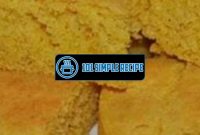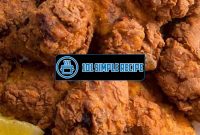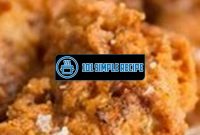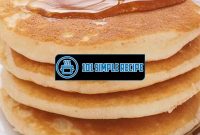Are you tired of running out of buttermilk for your baking recipes and not being able to find it at your local grocery store? Well, you’re in luck! Today, we’re here to reveal the secret to homemade buttermilk that will revolutionize your cooking endeavors. Whether you’re making fluffy pancakes, moist cakes, or tangy dressings, buttermilk adds a unique flavor and texture. Our easy-to-follow guide will help you whip up this versatile ingredient using just two simple pantry staples. So get ready to say goodbye to those last-minute trips to the store and start making your own delicious buttermilk at home.
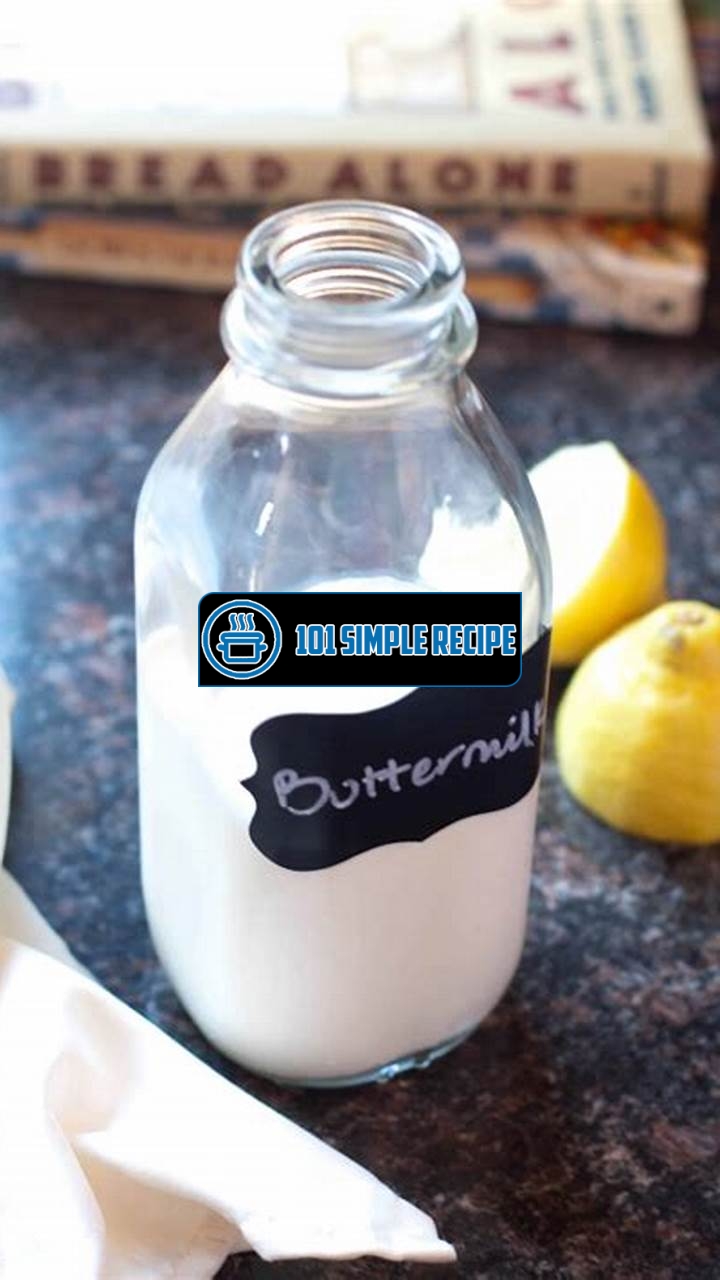
What is Buttermilk?
Buttermilk is a versatile ingredient commonly used in baking and cooking. It is a creamy and tangy dairy product that adds a rich flavor and texture to a variety of dishes. This beloved ingredient has a long history and is known for its unique properties that enhance the taste and quality of many recipes.
The Definition of Buttermilk
Buttermilk can be defined as the liquid that remains after churning butter from cream. It is the byproduct of the butter-making process. Traditionally, buttermilk was obtained by allowing raw milk to sit at room temperature until it naturally fermented. The natural bacteria in the milk caused the fermentation process, resulting in the production of lactic acid. This acid gives buttermilk its characteristic tangy taste.
Nowadays, the buttermilk available in stores is usually cultured buttermilk. Cultured buttermilk is created by adding lactic acid bacteria to pasteurized milk. The bacteria ferment the milk, replicating the natural fermentation process and creating the distinct flavor and texture of buttermilk.
The Origins of Buttermilk
The origins of buttermilk can be traced back to ancient times. It is believed that the process of churning butter and obtaining buttermilk was discovered accidentally by nomadic tribes. As they transported milk in animal skin bags, the constant movement and warm temperatures caused the milk to churn and separate into butter and buttermilk.
Throughout history, buttermilk has been consumed and cherished in many cultures. It was highly valued for its refreshing taste, nutritional benefits, and longer shelf life compared to fresh milk. Buttermilk was not only used for culinary purposes but also considered a medicinal drink with various health benefits.
The Varieties of Buttermilk
There are different varieties of buttermilk available today, each with its own characteristics and uses.
Note: The following varieties are discussed mainly for informational purposes and might not be widely available in all regions.
Traditional Buttermilk
Traditional buttermilk is the buttermilk that is obtained from the butter-making process. It has a tangy flavor and a creamy consistency. This type of buttermilk is becoming rarer to find, as most commercial buttermilk is now cultured.
Cultured Buttermilk
Cultured buttermilk is the most common type of buttermilk available today. It is made by introducing lactic acid bacteria to pasteurized milk, initiating the fermentation process. The bacteria convert the lactose in the milk into lactic acid, giving the buttermilk its signature tangy taste. Cultured buttermilk is widely used in baking, cooking, and even as a refreshing drink on its own.
Sweet Cream Buttermilk
Sweet cream buttermilk is a milder and sweeter version of buttermilk. It is made from the byproduct of churning sweet cream butter instead of regular butter. This type of buttermilk is less tangy and has a smoother flavor profile. Sweet cream buttermilk is often used in desserts and creamy sauces.
Soured Milk
Soured milk is similar to buttermilk but is made by adding an acidifying agent, such as vinegar or lemon juice, to regular milk. It is a common substitute for buttermilk in recipes that require a tangy flavor but don’t necessitate the specific properties of buttermilk. Soured milk can be easily made at home using pantry ingredients.
Now that you have discovered the secret to homemade buttermilk and learned about its definition, origins, and varieties, you can confidently incorporate this versatile ingredient into your culinary adventures. Whether you are baking fluffy pancakes, tender biscuits, or creating a creamy dressing, buttermilk is sure to elevate your dishes to a new level of deliciousness!
Whole Foods Chantilly Cake Recipe
The Health Benefits of Buttermilk
Buttermilk, a fermented dairy beverage, offers a plethora of health benefits when incorporated into a balanced diet. Packed with essential nutrients and known for its probiotic properties, buttermilk can improve digestive health and contribute to overall well-being. Let’s explore the various health benefits associated with consuming buttermilk.
Probiotic Properties of Buttermilk
One of the key reasons why buttermilk is hailed for its health benefits is due to its probiotic properties. Probiotics are beneficial bacteria that promote a healthy gut microbiome. Buttermilk contains these live cultures, such as lactobacillus and bifidobacterium, which help maintain the balance of gut flora. A healthy gut microbiome is essential for proper digestion, nutrient absorption, and a strong immune system.
The presence of probiotics in buttermilk also aids in promoting better mental health. Research has shown a strong connection between the gut and the brain, commonly referred to as the gut-brain axis. Probiotics from buttermilk can positively influence brain function and may help reduce symptoms of anxiety and depression.
Buttermilk’s Nutritional Value
Buttermilk is not only a probiotic powerhouse but also rich in essential nutrients. It provides a good source of protein, calcium, potassium, and phosphorus. Protein is necessary for building and repairing tissues, while calcium contributes to maintaining strong bones and teeth. Potassium helps regulate blood pressure, and phosphorus plays a vital role in energy production and bone health.
In addition to these essential nutrients, buttermilk contains vitamins such as vitamin B12, riboflavin (vitamin B2), and vitamin D. Vitamin B12 is crucial for red blood cell production and neurological function. Riboflavin assists in energy production and supports healthy skin and eyes. Vitamin D promotes calcium absorption and helps maintain healthy bones.
Buttermilk for Digestive Health
If you’re seeking improved digestive health, incorporating buttermilk into your diet is a great choice. The live cultures present in buttermilk aid in breaking down lactose, making it easier to digest for individuals with lactose intolerance. Additionally, buttermilk can alleviate symptoms of irritable bowel syndrome (IBS) and promote regular bowel movements due to its high probiotic content.
Buttermilk is also a natural remedy for acidity and heartburn. Drinking a glass of buttermilk can help neutralize stomach acid, providing relief from gastric issues. It can soothe the digestive system and reduce discomfort caused by indigestion.
It is important to note that while buttermilk offers several health benefits, individuals with dairy allergies or lactose intolerance should avoid consuming it.
In conclusion, buttermilk is a nutrient-rich beverage with probiotic properties that offer multiple health benefits. By including buttermilk in your diet, you can improve your digestive health, boost your nutrient intake, and support a healthy gut microbiome. So why not give it a try and reap the benefits of this delicious and nutritious drink!
Buttermilk Substitutes
When it comes to baking or cooking, buttermilk plays a crucial role in adding moisture, tenderness, and flavor to a wide range of recipes. However, there may be times when you find yourself without this essential ingredient. Fortunately, there are several substitutes you can use to achieve similar results in your culinary creations. Whether you need an acidic alternative, a non-dairy option, or a DIY substitute, we’ve got you covered. Let’s dive in and discover the secret to homemade buttermilk!
Acidic Substitutes for Buttermilk
If you’re looking for an acidic substitute for buttermilk, there are a variety of options available. These substitutes provide the tangy flavor and acidic properties that help activate baking soda and baking powder in recipes. You can use any of the following acidic ingredients to replace buttermilk:
- 1. Lemon Juice: Squeeze fresh lemon juice and combine it with milk to create an easy substitute. For every cup of milk, add 1 tablespoon of lemon juice and let it sit for about 5 minutes. The acidity from the lemon juice will mimic the tangy taste of buttermilk.
- 2. Vinegar: White vinegar or apple cider vinegar can also be used as an acidic substitute. For every cup of milk, add 1 tablespoon of vinegar and let it sit for a few minutes. The vinegar will curdle the milk slightly, creating a similar texture to buttermilk.
- 3. Yogurt: Plain yogurt, particularly the Greek variety, can be used as a replacement for buttermilk. Mix half a cup of yogurt with half a cup of water to achieve the desired consistency. The yogurt will add a creamy texture and tangy flavor to your recipes.
Note: When using acidic substitutes, it’s important to keep in mind that the taste and texture may not be exactly the same as using real buttermilk. However, they will still provide adequate results in most recipes.
Non-Dairy Alternatives for Buttermilk
For individuals who follow a dairy-free or vegan lifestyle, there are several non-dairy alternatives that can be used in place of buttermilk. These alternatives replicate the creamy texture and tanginess of traditional buttermilk, without the use of animal products. Here are some popular non-dairy substitutes:
- 1. Almond Milk: Use plain unsweetened almond milk as a substitute in a 1:1 ratio. The natural nutty flavor of almond milk adds a unique taste to your dishes.
- 2. Soy Milk: Soy milk is another great non-dairy option to replace buttermilk. Use it in equal parts as a substitute and enjoy the rich, creamy texture it adds to your recipes.
- 3. Coconut Milk: Full-fat coconut milk works well as a non-dairy alternative. It provides a rich, creamy consistency and a slight coconut flavor that adds depth to your dishes.
Note: Non-dairy alternatives may affect the taste and texture of your recipes slightly, so it’s important to consider the flavor profile you desire when choosing a substitute.
DIY Buttermilk Substitutes
If you don’t have any acidic substitutes or non-dairy alternatives on hand, you can easily create your own buttermilk substitute using common pantry ingredients. These DIY options can save the day when you’re in a pinch:
- 1. Milk and Cream of Tartar: Combine 1 cup of milk with 1 ¾ teaspoons of cream of tartar. Stir well and let it sit for a few minutes. The mixture will thicken slightly and provide the acidity needed for your recipes.
- 2. Milk and Lemon Juice: Similar to the previous method, mix 1 cup of milk with 1 tablespoon of lemon juice. Allow it to sit for a few minutes until it curdles slightly.
- 3. Sour Cream and Water: If you have sour cream on hand, dilute ⅔ cup of sour cream with ⅓ cup of water. The consistency should mimic that of buttermilk.
Note: These DIY substitutes may have a slightly different taste and texture compared to real buttermilk but can be used successfully in most recipes.
Now that you know the secret to homemade buttermilk and have discovered different substitutes for it, you can confidently tackle any recipe that calls for this essential ingredient. Whether you opt for an acidic substitute, a non-dairy alternative, or a DIY option, you’ll be able to achieve similar results in your culinary creations.
How to Make Buttermilk from Scratch
Are you tired of searching for buttermilk at your local grocery store? Why not make your own at home? With just a few simple ingredients and some basic equipment, you can whip up a batch of homemade buttermilk in no time. In this article, we will guide you through the step-by-step process of making buttermilk from scratch.
The Basic Buttermilk Recipe
To begin, you will need the following ingredients:
- Milk (preferably whole milk)
- White vinegar or lemon juice
Here’s how to make buttermilk:
- Pour 1 cup of milk into a measuring cup or bowl.
- Add 1 tablespoon of white vinegar or lemon juice to the milk. This acidic component is essential for creating the tangy flavor of buttermilk.
- Stir the mixture gently and let it sit at room temperature for about 10 minutes. This allows the milk to curdle and thicken, similar to traditional buttermilk production.
- Voila! Your homemade buttermilk is ready to use in your favorite recipes.
Keep in mind that the ratio of milk to acid can be adjusted depending on your taste preferences. Feel free to experiment with different measurements until you find the perfect balance for your homemade buttermilk.
Customizing Your Buttermilk
While the basic buttermilk recipe is simple and delicious on its own, you can also add additional flavorings to enhance your homemade buttermilk. Here are some ideas to get you started:
- Herbs and spices: Add a pinch of your favorite herbs and spices, such as dill, parsley, or garlic powder, to infuse your buttermilk with a savory twist.
- Sweeteners: If you prefer a sweeter buttermilk, try adding a teaspoon of honey, maple syrup, or sugar to the mixture.
- Fruit purees: For a fruity and refreshing flavor, blend some fresh or frozen fruits, such as strawberries or peaches, and mix them into the buttermilk.
Don’t be afraid to get creative and experiment with different flavor combinations. Just remember to start with small amounts of additional ingredients and adjust to taste.
Storing and Preserving Buttermilk
Once you have made your homemade buttermilk, you may be wondering how to store it properly. Here are a few tips to help you preserve its freshness:
- Transfer the buttermilk to an airtight container, such as a glass jar or a plastic container with a tight-fitting lid.
- Store the buttermilk in the refrigerator, where it will keep for up to two weeks. Make sure to place it in the coldest part of the fridge, such as the back shelf or the lower shelf. ❄️
- If you have made a larger batch of buttermilk and don’t plan on using it all within two weeks, consider freezing it for future use. Pour the buttermilk into individual ice cube trays, freeze them, and then transfer the frozen cubes into a freezer bag for easy portioning. This way, you can thaw only what you need for your recipes. ❄️
Remember to label your containers with the date to keep track of the freshness of your homemade buttermilk.
In conclusion, making buttermilk from scratch is a fun and rewarding process. By following these easy steps and customizing the flavors to your liking, you can enjoy the tangy goodness of homemade buttermilk in all your favorite dishes. So why wait? Give it a try today and taste the difference!
Recipes and Culinary Uses of Buttermilk
Discover a variety of delicious recipes and practical uses for buttermilk in your everyday cooking and baking. Buttermilk is a versatile ingredient that adds a tangy flavor and moist texture to a wide range of dishes. Whether you’re making pancakes, fried chicken, dressings, or marinades, buttermilk is your secret weapon in the kitchen.
Buttermilk Pancakes and Waffles
Start your day off right with fluffy and delicious buttermilk pancakes and waffles. The acidity in buttermilk helps to activate the leavening agents, resulting in light and tender breakfast treats. The secret to perfect buttermilk pancakes is to let the batter rest for at least 15 minutes before cooking. This allows the gluten to relax and creates a more tender texture. Serve your pancakes and waffles with a generous drizzle of maple syrup for a delightful morning meal.
Buttermilk Fried Chicken
Craving crispy and flavorful fried chicken? Look no further than buttermilk as your secret ingredient. Marinating chicken pieces in buttermilk not only tenderizes the meat but also imparts a tangy and savory flavor. The acidity in buttermilk helps to break down the proteins, resulting in moist and tender chicken. For an extra kick, add herbs and spices to the buttermilk marinade to infuse your fried chicken with even more flavor. Serve with mashed potatoes and coleslaw for a classic Southern-style meal.
Buttermilk Dressings and Marinades
Buttermilk is the star ingredient in creamy and tangy dressings. Whether you’re making ranch, blue cheese, or Caesar dressing, buttermilk adds a delightful tang and richness. The acidity in buttermilk helps to balance out the flavors and adds a refreshing element to your salad. It also makes a fantastic marinade for meats, especially pork and chicken. The enzymes in buttermilk help to tenderize the meat while infusing it with flavor. Whether you’re grilling, roasting, or pan-searing, buttermilk marinades will take your dishes to the next level.
Extra Detail: Buttermilk Biscuits
In addition to the well-known recipes and culinary uses of buttermilk, it’s worth highlighting the versatility of buttermilk when it comes to baking biscuits. Buttermilk biscuits are famous for their tender crumb and rich flavor. The acidity in buttermilk reacts with baking soda to create carbon dioxide, which helps the biscuits rise. The result is a batch of light and flaky biscuits that are perfect for breakfast, lunch, or dinner. Serve your buttermilk biscuits with jam, honey, or sausage gravy for a truly indulgent treat.
Buttermilk is a versatile ingredient that adds tangy flavor and moistness to your favorite recipes. From pancakes and waffles to fried chicken and dressings, buttermilk enhances the taste and texture of a wide range of dishes. Don’t forget to explore the world of buttermilk biscuits, where the acidity of buttermilk creates light and flaky treats. With these recipes and culinary uses, you’ll discover the secret to homemade buttermilk in no time!
So start experimenting with buttermilk in your kitchen and unlock the secret to delicious homemade meals. With its tangy flavor and creamy texture, buttermilk adds a unique twist to your favorite dishes. Whether you’re craving fluffy pancakes, crispy fried chicken, or creamy dressings, buttermilk is the key ingredient that will take your recipes to the next level. So don’t wait any longer, grab a carton of buttermilk and let your culinary adventure begin!
Thank you for reading this article on how to make buttermilk! We hope you found the step-by-step instructions and helpful tips useful. Making your own buttermilk at home is not only easy, but also a great way to enhance your recipes and add a tangy flavor to your dishes. Whether you’re using it in pancakes, biscuits, or dressings, homemade buttermilk is sure to elevate your cooking game. Remember, practice makes perfect, so don’t be afraid to experiment and find your preferred buttermilk consistency.
Frequently Asked Questions
Here are some frequently asked questions about making buttermilk:
| No. | Questions | Answers |
|---|---|---|
| 1. | Can I make buttermilk without using vinegar or lemon juice? | Yes, you can! Simply use plain yogurt or sour cream as a substitute. These dairy products will provide the acidity needed to create a similar effect as vinegar or lemon juice. |
| 2. | What can I do with leftover buttermilk? | Leftover buttermilk can be used in a variety of recipes. You can make pancakes, biscuits, cakes, or even use it as a marinade for chicken. It’s a versatile ingredient that adds a tangy and creamy flavor to dishes. |
| 3. | How long does homemade buttermilk last?⏳ | Homemade buttermilk can be stored in the refrigerator for up to 2 weeks. Make sure to keep it in an airtight container to maintain its freshness. |
| 4. | Can I freeze homemade buttermilk?❄️ | Yes, you can freeze homemade buttermilk. Pour it into an ice cube tray or freezer-safe container and store it for up to 3 months. Thaw it in the refrigerator before using. |
| 5. | Can I use plant-based milk to make buttermilk? | Yes, you can! Simply add 1 tablespoon of vinegar or lemon juice to 1 cup of plant-based milk, such as almond milk or soy milk, and let it sit for 5 minutes. The acidity will create a similar effect as traditional buttermilk. |
| 6. | Is buttermilk the same as heavy cream? + | No, buttermilk and heavy cream are not the same. Buttermilk is the liquid left over after churning butter, while heavy cream is a rich, high-fat dairy product often used in desserts and sauces. |
Closing Thoughts
We appreciate you taking the time to learn how to make buttermilk. By following the instructions in this article, you can easily create this versatile ingredient at home and enhance the flavors of your favorite dishes. Don’t be afraid to get creative and try different variations of buttermilk in your recipes. Remember to visit us again for more exciting culinary guides and tips! Happy cooking! ️
Jump to Recipe
Buttermilk Recipe

Learn how to make buttermilk at home with this easy step-by-step guide. Enhance the flavors of your dishes with tangy and creamy homemade buttermilk.
- 2 cups of whole milk
- 2 tablespoons of vinegar or lemon juice
- Pour 2 cups of whole milk into a mixing bowl.
- Add 2 tablespoons of vinegar or lemon juice to the milk.
- Stir the mixture gently and let it sit at room temperature for 5-10 minutes.
- After the designated time, you’ll notice that the milk has thickened slightly. Your homemade buttermilk is now ready to use!


